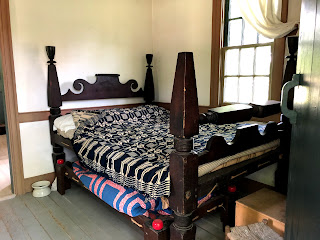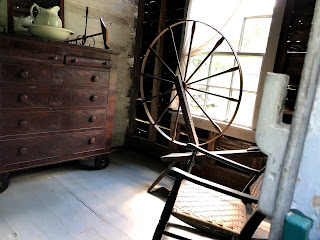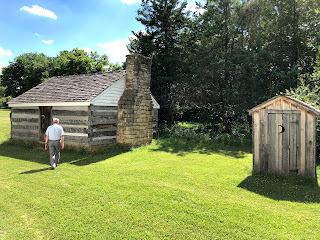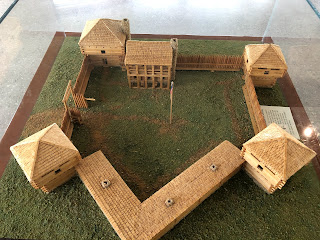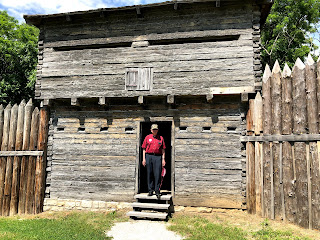Week 44--June 21-27, 2020

This has been Jesse James week. We started off the week visiting the Jesse James Birthplace and Farm in Kearney, Missouri.
Jesse James has been the subject of many movies over the years. One of the latest movies stars Brad Pitt as Jesse James and Casey Affleck as Tom Ford who is the man that killed Jesse James. Sensational publicity from newspapers and dime novels made Jesse's name a household word.
Jesse's remains were taken to the family farm and buried in the yard. His mother sat in her rocking chair and kept a watchful eye on her son's grave as grave robbing was a problem during this period in history. Tourists flocked to the farm and Jesse's mother would sell rocks off of his grave for 25 cents-a-piece. When she ran out of rocks she would replenish her stock from the nearby creek. Jesse's remains were later moved to Mt. Olivet Cemetery in Kearney next to his wife Zerelda (Nicknamed Zee).
We went with Elder and Sister Larsen.
 This is part of the original James' house that was built about 1822. Jesse's parents purchased the house and farm when they moved to Clay County in the 1840s. The logs are original. Jesse James, son of a Baptist minister, was born here in 1847.
This is part of the original James' house that was built about 1822. Jesse's parents purchased the house and farm when they moved to Clay County in the 1840s. The logs are original. Jesse James, son of a Baptist minister, was born here in 1847.
Jesse was 15 when the Civil War started. Union soldiers came to the farm looking for guerrillas. They beat Jesse trying to get information from him . This caused him to join Bloody Bill Anderson's guerrillas. His brother Frank rode with Quantrill's guerrillas.
This part of the house is called the Eastlake Cottage and was added in the 1890s. The kit for this part of the house was purchased from the east, shipped in, and built on site.
Many people owned slaves before the Civil War including the James family. This is a reconstruction of the slave quarters as it might have appeared in the 1870s and 1880s.
The furnishings in the one room slave cabins. Generally several slaves lived in the same quarters.
The original pump on the well.
After the Civil War, Jesse and Frank James turned to a life of outlawry by robbing banks and trains. There first robbery was this bank located in Liberty, Missouri. It is the only remaining antebellum (pre-Civil War) building on the square in Liberty. It was the first daylight bank robbery in history.
During their years as bank and train robbers, The James- Younger Gang, stole $225,000 which in today's economy would be $11,000,000. No one knows where it all went. You'd think that much money would lead to a lavish lifestyle or a cattle ranch, or something, to show where it went.
Artists rendition of the Liberty Bank robbery.
Tom by the vault in the bank. He wasn't trying to hold up the empty bank, his mask was a requirement to go into the museum.
Tom and Garnalee by the vault. We feel like bank robbers with our COVID-19 masks.
The counter where the bank clerk would wait on customers.
The clock shows the time when the bank was robbed--2 pm on Tuesday, February 13, 1866.
Picture of Jesse inside the vault.
The case inside the vault that held the money.
This is a file cabinet. The drawers would pull out and they had a spring loaded frame in each drawer.
What is left of the original shutters on the bank window. The shutters made of heavy steel, would be closed at night to protect the bank from being robbed. It didn't prove to be a deterrent for a daytime robbery.
We then traveled to St. Joseph, Missouri, to the home of Jesse and his wife, Zerelda. On the freeway we saw this vehicle with a load of carrier racing pigeons.
The Jesse James Home sits next to the Patee House which was a luxurious hotel in 1882 at the time of Jesse James' shooting. The family stayed at this hotel while the shooting was investigated. Jesse was shot by a member of his gang, Tom Ford, to collect the $10,000 reward offered by Governor Chittenden.
Tom and the Larsens next to the Patee House.
The Patee House was also the headquarters for the Pony Express when it started on April 3, 1860 and ran until October 1861. This mural is painted on one the buildings in St. Joseph.
It would take a letter ten days to get to California via the Pony Express and would cost $5 per 1/2 ounce. We complain about the 55 Cents to mail a letter today. The 2,000 mile trip means the rider would have to cover an average of 200 miles per day.
Saddle of the Pony Express rider.
Today the Patee House is a museum of Western history. The stagecoach was the "Greyhound Bus" of the west in the 1860s, providing the only way to travel from city to city before the trains and automobiles replaced them. The coaches carried six to nine passengers inside with room for another six on top. The Central Overland Express left daily from the Patee House for that 2000 mile trip to California. The coaches floated on leather straps that often left the riders "seasick."
The box where the driver sat is more that six feet off the ground. This brightly painted original looks better than ever.
Civil War Cannon. The cannon balls were about the size of a baseball.
 Each bank would print their own currency.
Each bank would print their own currency.
Walter Cronkite was born and grew in St. Joseph. This is the dentist office of his father Dr. Walter Cronkite.
Jane Wyman, former wife of President Ronald Reagan, was also from St. Joseph.
1927 Studebaker "President" Limousine. Before they made cars, the Studebakers made carriages and wagons in St. Joseph.
The Hannibal and St. Joseph Railroad was the first in the nation to extend as far west as St. Joseph. This is the last Hannibal steam locomotive.
The boiler on the steam engine.
Railway mail car that was invented to speed the mail onto the Pony Express in St. Joseph for the rest of the trip to San Farncisco. However, the Pony Express went broke before the car was completed. The car was set up like a post office and the return mail was sorted while the train traveled from St. Joseph, Missouri to Quincy, Ohio.
"Wild Thing" Carousel at the Patee House.
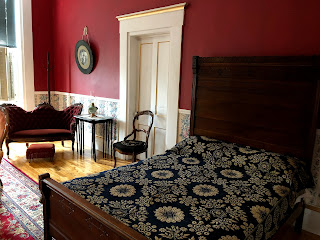 One of the suites in the Patee House. It was the most elegant hotel for miles around.
One of the suites in the Patee House. It was the most elegant hotel for miles around.
The other side of the suite.
Display in Sedelia where the Missouri State Fair is held in August.
We traveled from Independence to Marshall to Sedelia to Warrensburg to Clinton to Harrisonville to Lee's Summit to Raytown doing missionary apartment inspections on Wednesday. We drove 234 miles that day.
A picture of the many fire flies we are seeing each night. They're difficult to photograph because the flash lasts only an instant. Garnalee videoed these two and then isolated a single frame.

This has been Jesse James week. We started off the week visiting the Jesse James Birthplace and Farm in Kearney, Missouri.
Jesse James has been the subject of many movies over the years. One of the latest movies stars Brad Pitt as Jesse James and Casey Affleck as Tom Ford who is the man that killed Jesse James. Sensational publicity from newspapers and dime novels made Jesse's name a household word.
Jesse's remains were taken to the family farm and buried in the yard. His mother sat in her rocking chair and kept a watchful eye on her son's grave as grave robbing was a problem during this period in history. Tourists flocked to the farm and Jesse's mother would sell rocks off of his grave for 25 cents-a-piece. When she ran out of rocks she would replenish her stock from the nearby creek. Jesse's remains were later moved to Mt. Olivet Cemetery in Kearney next to his wife Zerelda (Nicknamed Zee).
We went with Elder and Sister Larsen.
 This is part of the original James' house that was built about 1822. Jesse's parents purchased the house and farm when they moved to Clay County in the 1840s. The logs are original. Jesse James, son of a Baptist minister, was born here in 1847.
This is part of the original James' house that was built about 1822. Jesse's parents purchased the house and farm when they moved to Clay County in the 1840s. The logs are original. Jesse James, son of a Baptist minister, was born here in 1847.Jesse was 15 when the Civil War started. Union soldiers came to the farm looking for guerrillas. They beat Jesse trying to get information from him . This caused him to join Bloody Bill Anderson's guerrillas. His brother Frank rode with Quantrill's guerrillas.
This part of the house is called the Eastlake Cottage and was added in the 1890s. The kit for this part of the house was purchased from the east, shipped in, and built on site.
Many people owned slaves before the Civil War including the James family. This is a reconstruction of the slave quarters as it might have appeared in the 1870s and 1880s.
The furnishings in the one room slave cabins. Generally several slaves lived in the same quarters.
The original pump on the well.
After the Civil War, Jesse and Frank James turned to a life of outlawry by robbing banks and trains. There first robbery was this bank located in Liberty, Missouri. It is the only remaining antebellum (pre-Civil War) building on the square in Liberty. It was the first daylight bank robbery in history.
During their years as bank and train robbers, The James- Younger Gang, stole $225,000 which in today's economy would be $11,000,000. No one knows where it all went. You'd think that much money would lead to a lavish lifestyle or a cattle ranch, or something, to show where it went.
Artists rendition of the Liberty Bank robbery.
Tom by the vault in the bank. He wasn't trying to hold up the empty bank, his mask was a requirement to go into the museum.
Tom and Garnalee by the vault. We feel like bank robbers with our COVID-19 masks.
The counter where the bank clerk would wait on customers.
The clock shows the time when the bank was robbed--2 pm on Tuesday, February 13, 1866.
Picture of Jesse inside the vault.
The case inside the vault that held the money.
This is a file cabinet. The drawers would pull out and they had a spring loaded frame in each drawer.
What is left of the original shutters on the bank window. The shutters made of heavy steel, would be closed at night to protect the bank from being robbed. It didn't prove to be a deterrent for a daytime robbery.
We then traveled to St. Joseph, Missouri, to the home of Jesse and his wife, Zerelda. On the freeway we saw this vehicle with a load of carrier racing pigeons.
The Jesse James Home sits next to the Patee House which was a luxurious hotel in 1882 at the time of Jesse James' shooting. The family stayed at this hotel while the shooting was investigated. Jesse was shot by a member of his gang, Tom Ford, to collect the $10,000 reward offered by Governor Chittenden.
Tom and the Larsens next to the Patee House.
The Patee House was also the headquarters for the Pony Express when it started on April 3, 1860 and ran until October 1861. This mural is painted on one the buildings in St. Joseph.
It would take a letter ten days to get to California via the Pony Express and would cost $5 per 1/2 ounce. We complain about the 55 Cents to mail a letter today. The 2,000 mile trip means the rider would have to cover an average of 200 miles per day.
Saddle of the Pony Express rider.
Today the Patee House is a museum of Western history. The stagecoach was the "Greyhound Bus" of the west in the 1860s, providing the only way to travel from city to city before the trains and automobiles replaced them. The coaches carried six to nine passengers inside with room for another six on top. The Central Overland Express left daily from the Patee House for that 2000 mile trip to California. The coaches floated on leather straps that often left the riders "seasick."
The box where the driver sat is more that six feet off the ground. This brightly painted original looks better than ever.
Civil War Cannon. The cannon balls were about the size of a baseball.
 Each bank would print their own currency.
Each bank would print their own currency.Walter Cronkite was born and grew in St. Joseph. This is the dentist office of his father Dr. Walter Cronkite.
Jane Wyman, former wife of President Ronald Reagan, was also from St. Joseph.
1927 Studebaker "President" Limousine. Before they made cars, the Studebakers made carriages and wagons in St. Joseph.
The Hannibal and St. Joseph Railroad was the first in the nation to extend as far west as St. Joseph. This is the last Hannibal steam locomotive.
The boiler on the steam engine.
Railway mail car that was invented to speed the mail onto the Pony Express in St. Joseph for the rest of the trip to San Farncisco. However, the Pony Express went broke before the car was completed. The car was set up like a post office and the return mail was sorted while the train traveled from St. Joseph, Missouri to Quincy, Ohio.
"Wild Thing" Carousel at the Patee House.
 One of the suites in the Patee House. It was the most elegant hotel for miles around.
One of the suites in the Patee House. It was the most elegant hotel for miles around.The other side of the suite.
Display in Sedelia where the Missouri State Fair is held in August.
We traveled from Independence to Marshall to Sedelia to Warrensburg to Clinton to Harrisonville to Lee's Summit to Raytown doing missionary apartment inspections on Wednesday. We drove 234 miles that day.
A picture of the many fire flies we are seeing each night. They're difficult to photograph because the flash lasts only an instant. Garnalee videoed these two and then isolated a single frame.
































































